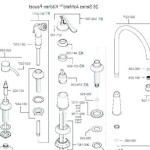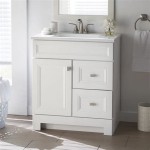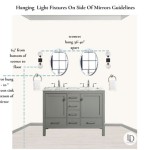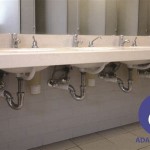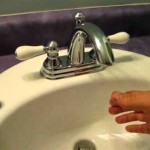Bathroom Sinks Without Overflow: A Comprehensive Guide
The absence of an overflow drain constitutes a significant design choice in bathroom sink construction. A bathroom sink without overflow offers a streamlined aesthetic and, in certain applications, presents functional advantages. However, this design also demands careful consideration of plumbing configuration, user habits, and overall bathroom design to prevent potential water damage. This article provides a detailed examination of bathroom sinks without overflows, covering their benefits, limitations, installation considerations, and available styles.
Bathroom sinks traditionally incorporate an overflow drain, a small opening typically located beneath the faucet that allows excess water to escape the basin before it spills over the edge. This overflow is connected to the main drainpipe, providing a secondary route for water disposal. In sinks lacking this feature, all water must exit through the primary drain, a characteristic that fundamentally alters the user experience and necessitates a heightened awareness of water levels.
The decision to opt for a bathroom sink without overflow often stems from aesthetic preferences. Many modern bathroom designs prioritize minimalist aesthetics. The clean lines achieved by eliminating the overflow opening contribute to a sleek and uncluttered appearance. Furthermore, certain sink materials or manufacturing processes may make incorporating an overflow drain challenging or aesthetically undesirable. From a design standpoint, the absence of an overflow makes the sink look more contemporary and sophisticated.
Aesthetic and Design Considerations
The primary advantage of a bathroom sink without overflow lies in its minimalist aesthetic. The absence of the overflow drain creates a cleaner, more seamless look, allowing the sink's design and material to take center stage. This is particularly appealing in contemporary bathroom designs that emphasize simplicity and elegance. Vessel sinks, for instance, often forego overflow drains to maintain their distinctive appearance. The focus shifts to the shape and form of the sink itself, enhancing its sculptural qualities.
Furthermore, certain sink materials, such as cast iron with specialized enamels or intricately patterned ceramics, may be more difficult or costly to manufacture with an overflow drain. Omitting the overflow allows for a more streamlined production process and potentially reduces the overall cost of the sink. In some cases, the inclusion of an overflow might disrupt the visual flow of the design, particularly with sinks featuring unique textures or patterns. The uninterrupted surface of a sink without overflow allows these features to be fully appreciated.
The choice of faucet also plays a crucial role in the overall aesthetic. A faucet with clean lines and a minimalist design complements a sink without overflow, further enhancing the contemporary look. Conversely, a more ornate or traditional faucet may clash with the streamlined appearance of the sink. Careful consideration should be given to the faucet's finish and style to ensure visual harmony within the bathroom.
Functional Implications and Precautions
While aesthetically pleasing, bathroom sinks without overflows require greater user diligence. The absence of an overflow mechanism means that the sink can easily overflow if the drain is blocked or if the water is left running unattended. This necessitates a more conscious approach to using the sink and a prompt response to any potential drainage issues. Users must be aware of the water level and avoid overfilling the sink.
In households with young children or individuals prone to distraction, a bathroom sink without overflow may not be the most practical choice. The risk of overflowing and subsequent water damage is significantly higher in situations where attention to detail is limited. In such cases, the traditional overflow drain provides a valuable safeguard against accidental flooding.
The type of drain assembly installed with the sink is also crucial. A pop-up drain, for example, can be easily closed accidentally, leading to an overflow if the water is left running. A grid drain, which remains permanently open, may be a more suitable option for sinks without overflows, as it prevents accidental closure of the drain and allows for continuous water flow. The selection of the drain assembly should be carefully considered to mitigate the risk of overflowing.
Regular maintenance of the drain is essential to prevent clogs and ensure proper drainage. Hair, soap scum, and other debris can accumulate in the drainpipe, restricting water flow and increasing the likelihood of overflowing. Periodic cleaning with a drain snake or chemical drain cleaner can help to maintain optimal drainage and prevent potential problems. Routine checks of the drain's functionality are recommended.
Installation and Plumbing Considerations
Installing a bathroom sink without overflow requires careful consideration of the existing plumbing configuration. The absence of an overflow drain eliminates the need for a connecting pipe to the main drain, simplifying the installation process to some extent. However, the plumber must ensure that the drainpipe is properly aligned and sealed to prevent leaks. A watertight connection is crucial to avoid water damage to the surrounding cabinetry and flooring.
The sink's drainpipe must be properly vented to allow air to flow freely, preventing siphoning and ensuring efficient drainage. Inadequate venting can lead to slow drainage, gurgling noises, and potential sewer gas odors. A professional plumber can assess the existing plumbing system and recommend the appropriate venting solution for the new sink. Proper venting is essential for maintaining a healthy plumbing system.
The height of the sink and the length of the drainpipe must also be carefully considered to ensure proper drainage and prevent backflow. The drainpipe should have a slight downward slope to facilitate water flow. Insufficient slope can lead to stagnant water and potential clogs. The placement of the sink in relation to the existing plumbing fixtures is also a factor that should be taken into account during the installation process.
The choice of sealant used to install the drain assembly is also critical. A high-quality, waterproof sealant should be used to create a watertight seal between the sink and the drain fitting. This will prevent leaks and protect the surrounding surfaces from water damage. The sealant should be applied according to the manufacturer's instructions to ensure a proper seal. Improperly applied sealant can lead to leaks and costly repairs.
Furthermore, the selection of the P-trap, a U-shaped pipe that traps debris and prevents sewer gases from entering the bathroom, is equally important. The P-trap should be properly sized to accommodate the drainpipe and should be installed according to local plumbing codes. A leaking or improperly installed P-trap can create unsanitary conditions and potentially damage the surrounding structure. A professional plumber can ensure that the P-trap is correctly installed and functioning properly.
Consideration should be given to the type of drain stopper used with the sink. If a pop-up drain is selected, its potential for accidental closure should be weighed against its convenience of use. A grid drain, while less convenient for filling the sink, offers a more reliable solution for preventing overflows. The choice of drain stopper should align with the user's habits and the overall risk tolerance for potential water damage.
In summary, while bathroom sinks without overflows offer a sleek and modern aesthetic, they demand a higher level of user awareness and careful consideration of plumbing configurations. Proper installation, regular maintenance, and mindful usage are essential to prevent potential water damage and ensure the long-term functionality of the sink. The decision to choose a sink without overflow should be based on a thorough assessment of aesthetic preferences, functional needs, and individual user habits.

Zeek Dc150 Chrome Pop Up Drain With Overflow

American Imaginations Vessel Bathroom Sink Without Overflow Round Shape 14 09 In X White Ai 27848 Rona

Pf Waterworks Decodrain Grid Strainer Drain For Bathroom Vanity Lavatory Vessel Sink Without Overflow In Oil Rubbed Broe Pf0727 Orb The Home Depot

Bathroom Vessel Sink Pop Up Drain Without Overflow Chrome Finish

Bwe 1 5 8 In Bathroom Sink Pop Up Drain Without Overflow Polished Chrome A 9p 006 The Home Depot

Keeney 1 4 In Push On Bathroom Sink Drain Without Overflow Brushed Nickel K820 76bn The Home Depot

Bathroom Sink Without Overflow In Spot Free Stainless Steel Kraus

Stylish Bathroom Vanity Sink Pop Up Drain Without Overflow Brushed Nickel D 702b Rona

Bathroom Sink Pop Up Drain Stopper Small Cover Without Overflow Kpw101 Kibi Usa

Hansgrohe Washbasins Xelu Q Countertop Basin Ground 600 480 With Tap Hole Without Overflow Smartclean Item No 61018450
Related Posts


